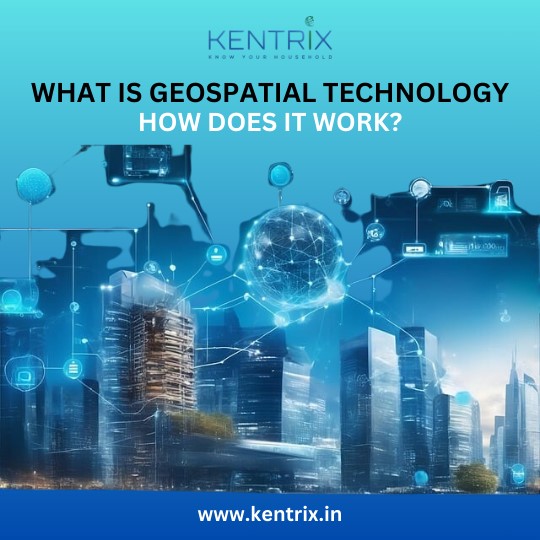Geospatial technology has become a cornerstone in various industries, providing essential tools for collecting, analyzing, and visualizing spatial data. This technology is integral to sectors such as urban planning, environmental management, transportation, and disaster response. In this blog, we will explore what geospatial technology is, how it works, its components, applications, and its significance in modern society. Additionally, we will highlight Geomarketeer, a powerful tool developed by Kentrix Solutions that leverages geospatial technology for enhanced market intelligence.
Understanding Geospatial Technology
Geospatial technology refers to a set of tools and techniques that enable the collection, analysis, interpretation, and visualization of geographic data. At its core, geospatial technology focuses on the spatial relationships between different points on the Earth’s surface. This technology encompasses several disciplines, including Geographic Information Systems (GIS), Remote Sensing (RS), and Global Positioning Systems (GPS).
Key Components of Geospatial Technology
1. Geographic Information Systems (GIS):
- GIS is a framework for gathering, managing, and analyzing spatial data. It allows users to visualize data in map form and analyze relationships between various geographic features. GIS integrates various data layers—such as demographic information, land use patterns, and infrastructure details—to provide comprehensive insights into spatial phenomena.
- How It Works: GIS operates by layering different types of data on top of one another. For instance, a city planner might overlay population density data with transportation networks to identify areas in need of new infrastructure.
2. Remote Sensing (RS):
- Remote sensing involves collecting data about the Earth’s surface from a distance using satellite or aerial imagery. This technique allows for the monitoring of environmental changes, urban expansion, and natural disasters without direct contact with the area being studied.
- How It Works: Remote sensing uses sensors mounted on satellites or aircraft to capture images of the Earth. These sensors may utilize various wavelengths of light to gather information about land cover, vegetation health, and water bodies.
3. Global Positioning System (GPS):
- GPS is a satellite-based navigation system that provides location information anywhere on Earth. It is widely used for mapping and navigation purposes.
- How It Works: GPS operates through a network of satellites that transmit signals to GPS receivers on the ground. By calculating the time it takes for signals to reach the receiver from multiple satellites, the system can determine an accurate location.
How Geospatial Technology Works
The process of utilizing geospatial technology involves several key steps:
1. Data Collection:
- The first step in geospatial technology involves gathering data from various sources. This can include satellite imagery, aerial photography (from drones or planes), GPS coordinates, and field surveys.
- Different sensors are employed depending on the type of data needed. For example, LiDAR (Light Detection and Ranging) can be used for high-resolution topographic mapping.
2. Data Processing:
- Once collected, geospatial data must be processed to ensure accuracy and usability. This includes cleaning the data to remove errors and organizing it into formats suitable for analysis.
- Data processing may involve converting raw sensor data into usable formats or integrating multiple datasets into a single database.
3. Data Analysis:
- After processing, the data is analyzed using specialized software tools that allow users to explore spatial relationships and patterns.
- Analysts can perform various types of analysis such as overlay analysis (to compare different datasets), buffer analysis (to assess areas around specific features), and spatial interpolation (to estimate values in unmeasured areas).
4. Visualization:
- The final step involves visualizing the results of the analysis through maps or 3D models. Visualization helps stakeholders understand complex spatial relationships and make informed decisions based on geographic context.
- Modern GIS software allows for interactive maps that users can manipulate to view different layers of information.
Applications of Geospatial Technology
Geospatial technology has a wide range of applications across various sectors:
1. Urban Planning and Management
- Designing cities, monitoring land use, and managing infrastructure.
- Mapping urban growth and planning transportation networks.
2. Environmental Monitoring and Conservation
- Tracking deforestation, climate change, and wildlife habitats.
- Monitoring natural disasters like floods, hurricanes, and earthquakes.
3. Agriculture and Precision Farming
- Optimizing crop yields using soil and weather data.
- Monitoring irrigation and pest control through satellite imagery.
4. Disaster Management
- Predicting and managing disaster risks using GIS and remote sensing.
- Coordinating rescue and relief operations during emergencies.
5. Transportation and Navigation
- Real-time route optimization and traffic management.
- Developing autonomous vehicle navigation systems.
6. Healthcare and Epidemic Tracking
- Mapping disease outbreaks and health resource allocation.
- Planning vaccination drives and public health initiatives.
7. Natural Resource Management
- Mapping mineral resources and water bodies.
- Sustainable forest and fisheries management.
8. Defense and Security
- Strategic military planning and border security monitoring.
- Surveillance and reconnaissance using satellite data.
9. Retail and Business Analytics
- Identifying optimal locations for new stores.
- Analyzing consumer behavior patterns based on geospatial data.
10. Tourism and Recreation
- Creating interactive maps for tourist destinations.
- Managing and promoting natural parks and heritage sites.
11. Telecommunications and Network Planning
- Designing and optimizing network coverage for mobile operators.
- Identifying locations for new communication towers.
12. Education and Research
- Teaching spatial analysis and geography in schools and universities.
- Conducting research in fields like archaeology and urban studies.
The Significance of Geospatial Technology
The importance of geospatial technology cannot be overstated:
1. Enhanced Decision-Making: By providing accurate spatial insights, geospatial technology enables organizations to make informed decisions based on geographic context.
2. Resource Management: It allows for efficient allocation of resources by identifying high-priority areas based on spatial analysis.
3. Improved Communication: Visual representations of geographic data facilitate better communication among stakeholders by making complex information more accessible.
4. Sustainable Development: Geospatial technology supports sustainable practices by helping organizations understand their impact on the environment and plan accordingly.
The Role of Geomarketeer in Geospatial Technology
One notable application of geospatial technology is through Kentrix’s Geomarketeer, which provides businesses with powerful tools for analyzing market potential through geo-location intelligence.
Key Features:
- Granular Market Segmentation: Geomarketeer allows businesses to identify specific market segments based on consumer demographics and behavior at a micro-level.
- Consumer Density Mapping: The platform visualizes consumer density across geographical areas to identify high-potential locations for expansion.
- Store Catchment Analysis: Businesses can analyze catchment areas around stores to optimize site selection strategies effectively.
- Real-Time Data Queries: Users can access up-to-date insights into consumer behavior for timely decision-making.
- Private Room Access: Each user can create their own private access login ensuring that their analytics remain confidential.
Benefits:
- Enhanced Decision-Making Capabilities: By leveraging detailed geospatial insights from Geomarketeer, businesses can make informed decisions about marketing strategies and resource allocation.
- Improved Marketing Efficiency: Businesses can tailor their marketing efforts based on precise consumer profiles derived from geo-location data.
- Cost Efficiency: The ability to identify high-potential markets allows organizations to focus their resources effectively, reducing wasted advertising spend while maximizing return on investment (ROI).
- Increased Customer Insights: Detailed consumer profiles generated by Geomarketeer provide valuable information about customer behavior and preferences that help refine product offerings.
Challenges in Geospatial Technology
Despite its advantages, geospatial technology faces several challenges:
- Data Privacy Concerns: The collection of location-based data raises privacy issues that organizations must address through robust policies.
- Data Quality Issues: Ensuring the accuracy and reliability of collected data is crucial for effective analysis.
- Integration with Existing Systems: Organizations may struggle to integrate new geospatial technologies with their existing systems and workflows.
Conclusion
Geospatial technology represents a transformative force across various industries by providing essential tools for analyzing spatial relationships and making informed decisions based on geographic context. With components such as GIS, remote sensing, GPS working together seamlessly—and innovative solutions like Geomarketeer enhancing its application—this technology empowers organizations to tackle complex challenges related to urban planning, environmental management, transportation logistics, disaster response, and more.
As we continue to advance into an increasingly interconnected world where location plays a vital role in decision-making processes, understanding how geospatial technology works will be crucial for professionals across all sectors. By leveraging these powerful tools effectively while addressing challenges related to privacy and data quality, we can harness the full potential of geospatial technology to foster sustainable development and improve quality of life globally.



